Quick search
CTRL+K
Quick search
CTRL+K

Sarajevo is the capital of Bosnia-Herzegovina and it is a beautifully located city with many sights to see. The Ottoman Bazaar Quarter is as an atmospheric center, surrounded by the beautiful 19th-century Habsburg buildings, constructed in the decades leading up to World War I, where Sarajevo was growing rapidly.
Sarajevo’s name is historically linked to World War I, when Archduke Franz Ferdinand was murdered during a visit here in 1914. Historically interested visitors can see the place where it happened and learn more about both that year and much more from the city’s history at Sarajevo’s museums.
For centuries, Sarajevo was part of the Ottoman Empire, and hostels, bazaars and mosques are examples of the 16th-century city. Narrow streets and a cozy setting for, among other things, shopping and gastronomy characterize the place today.
Many beautiful houses and churches in Austrian era Sarajevo are just a few steps away. These include, for example, the City Hall, the Catholic Cathedral and Sarajevo’s National Theater. You can also choose a walk across the river to the Sarajevska Pivara brewery, which serves good local beer at the on-site restaurant.
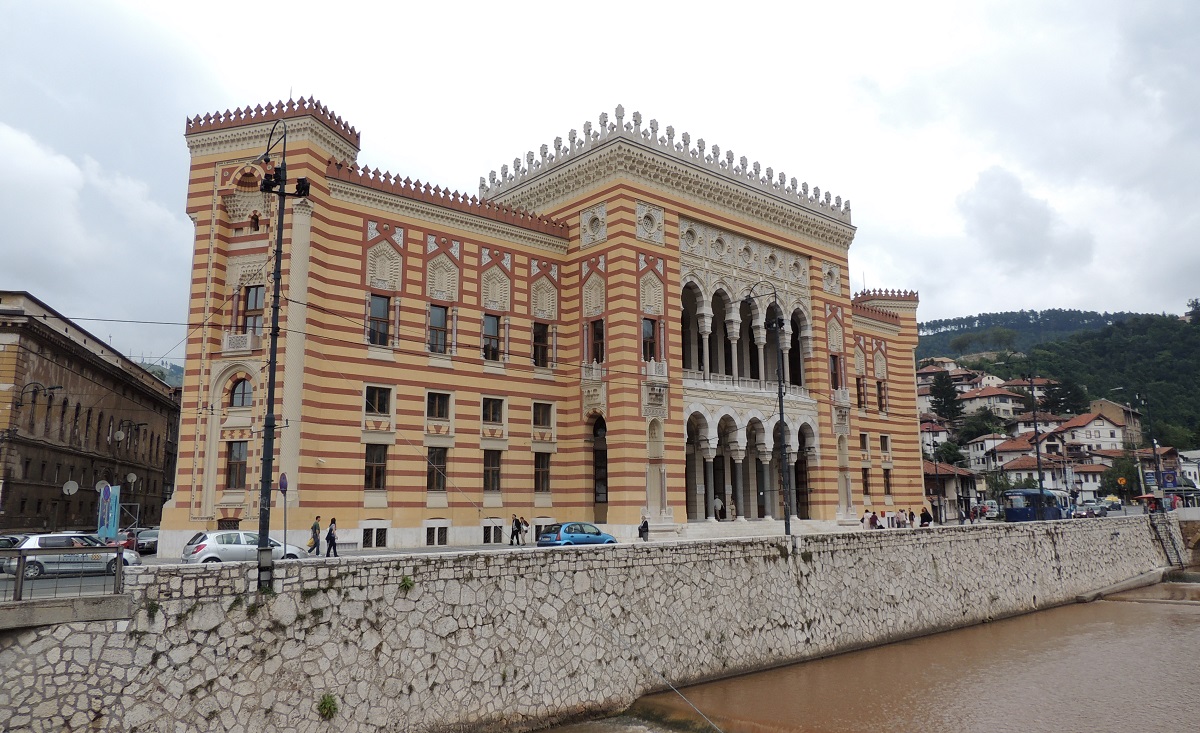
Sarajevo’s City Hall was built in Moorish-inspired style in 1896, and it became part of world history in 1914. It was here that the Austrian Archduke Franz Ferdinand had attended a reception on June 28, 1914, immediately before he was assassinated. It was a killing that helped start the First World War.
The town hall was set up as a national library in 1949 and functioned as such until it was bombed and burnt down during the siege of the city in 1992. During the fire, many distinguished works of a total of two million destroyed books and manuscripts were lost.
To mark the 100th anniversary of the assassination of Franz Ferdinand, the town hall was rebuilt and rededicated in 2014. It houses both the city council and Sarajevo’s national and university libraries and stands in its former glory along the river.
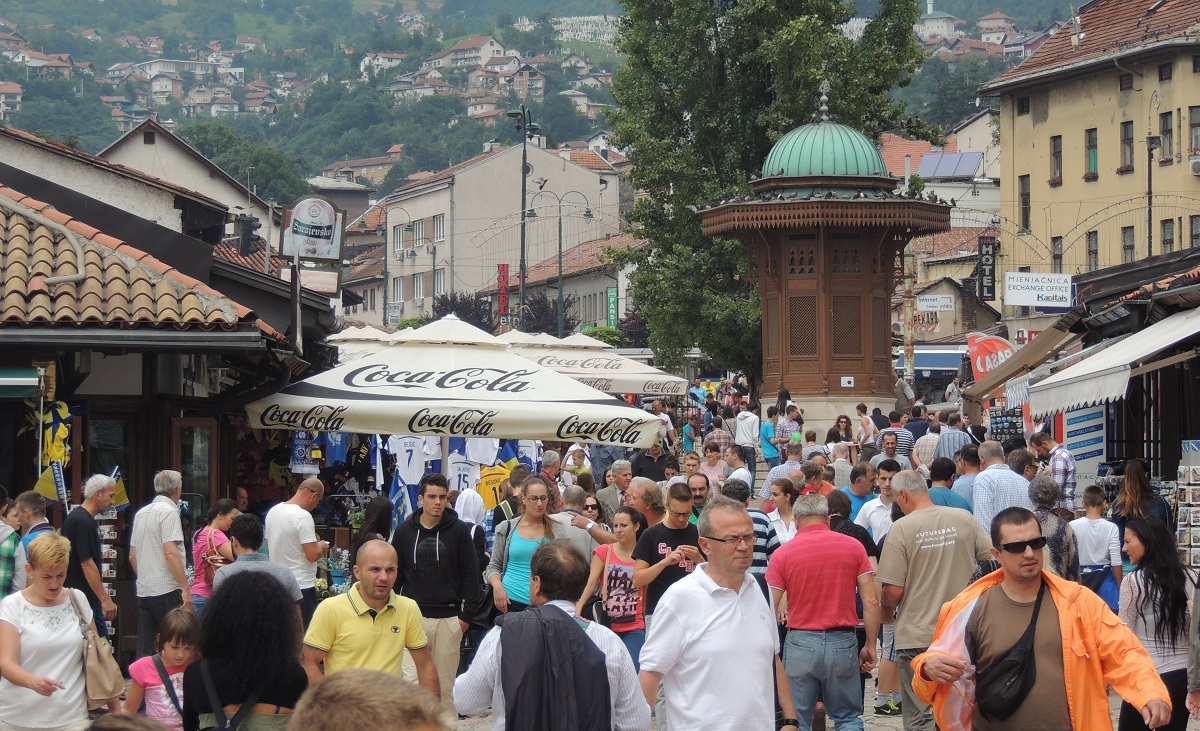
Baščaršija is Sarajevo’s old bazaar, and this neighborhood forms the city’s historical and cultural center. The place was thus founded in the 15th century, when the Ottoman general Isa-Beg Isaković as Bosnian governor founded Sarajevo itself in 1461.
In the first centuries, many shops and markets were established here, and mosques and hostels for travellers, for example, were built. These were the so-called caravansarai.
Baščaršija used to be somewhat larger than today, but after a fire in the 1800s it got its current size. You can clearly see in the street view that the fire raged around the street Ferhadija, where the more modern city is located.
There are several attractions in Baščaršija’s exciting and atmospheric streets; eg mosques and market buildings. In the central square is the fine kiosk-like building Sebilj, which stands as a landmark for the district and is a must during a visit. Shopping, atmosphere and a number of places to eat are easily found by exploring here.
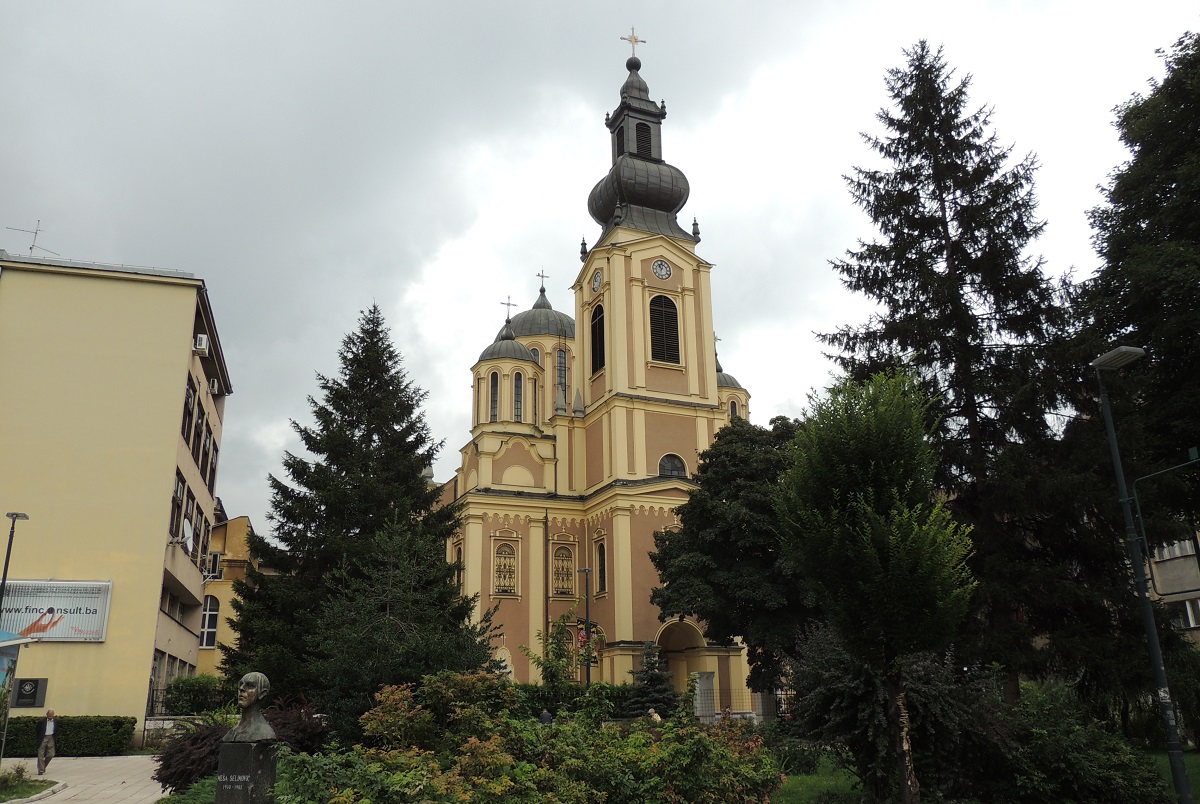
The Church of the Nativity of the Theotokos is the largest Serbian Orthodox church in Sarajevo and one of the largest in the Balkans. It was built in the years 1863-1868 in a design with a main dome and four smaller side domes. In front of the church stands the bell tower of the complex, built in Baroque style.
Most of the funds for the construction were donated by Serbian merchants in Sarajevo, but both the Ottoman Sultan and the Serbian Regent contributed symbolically to the construction. Furthermore, Tsar Alexander II of Russia sent skilled craftsmen to produce the church’s iconostasis.
The church’s inauguration was planned for 1871, but this had to be postponed due to Muslim opposition to this Christian building, which was a prominent part of the city’s streetscape. It came to physical protests in the street, where the police had to be deployed, and representatives of the city’s Serbs complained to the city’s Russian consul, who formally complained to the Ottoman Sultan. The result was an inauguration on 20 July 1872, and at this event there were both representatives and soldiers from the Sultan.
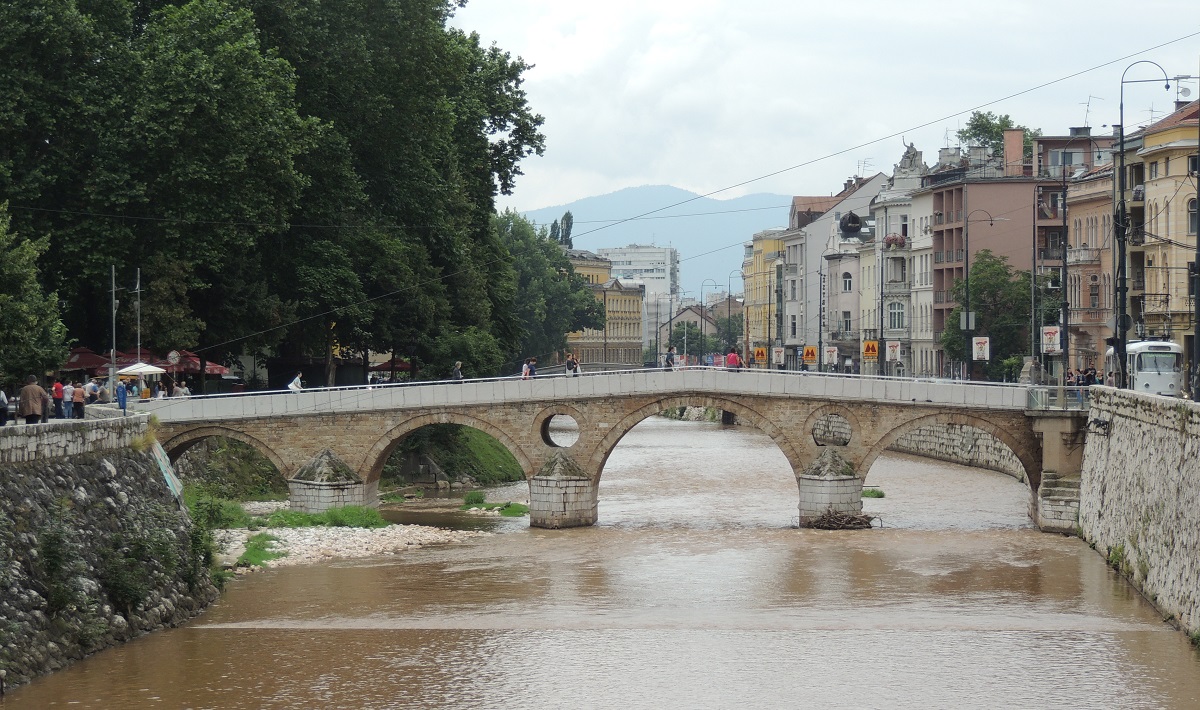
The Latin Bridge is a bridge over the river Miljacka that runs through Sarajevo. A bridge is already mentioned at this place in 1541, and this was a wooden bridge, as the stone bridge was first built under the Ottomans in 1565. The bridge stands with four arches and the characteristic holes through two of the bridge piers; this distinctive feature can be found on Sarajevo’s city coat of arms.
The Latin Bridge is not only known because of its ancient history. It was also immediately north of it that Gavrilo Princip shot and killed the Austro-Hungarian heir to the throne on 28 June 1914.
Brusa Bezistan with its six domes is one of the most interesting buildings in the old bazaar area of Baščaršija. The building was built by order of Sultan Suleiman the Mighty’s Grand Vizier Rustem Pasha in 1551, and it was built as a trading post for silk. Brusa Bezistan is also named after the Turkish city of Bursa, from where the offered silk was transported.
The stone building is 29.5×20.5 meters in ground plan, and there are entrances on all four sides. Today, Brusa Bezistan is set up as part of Sarajevo’s museums, and here the city’s history is told from prehistoric times up to and including the Austro-Hungarian era. Around it are shops, as in the rest of the bazaar area, and they help to give the museum extra atmosphere.
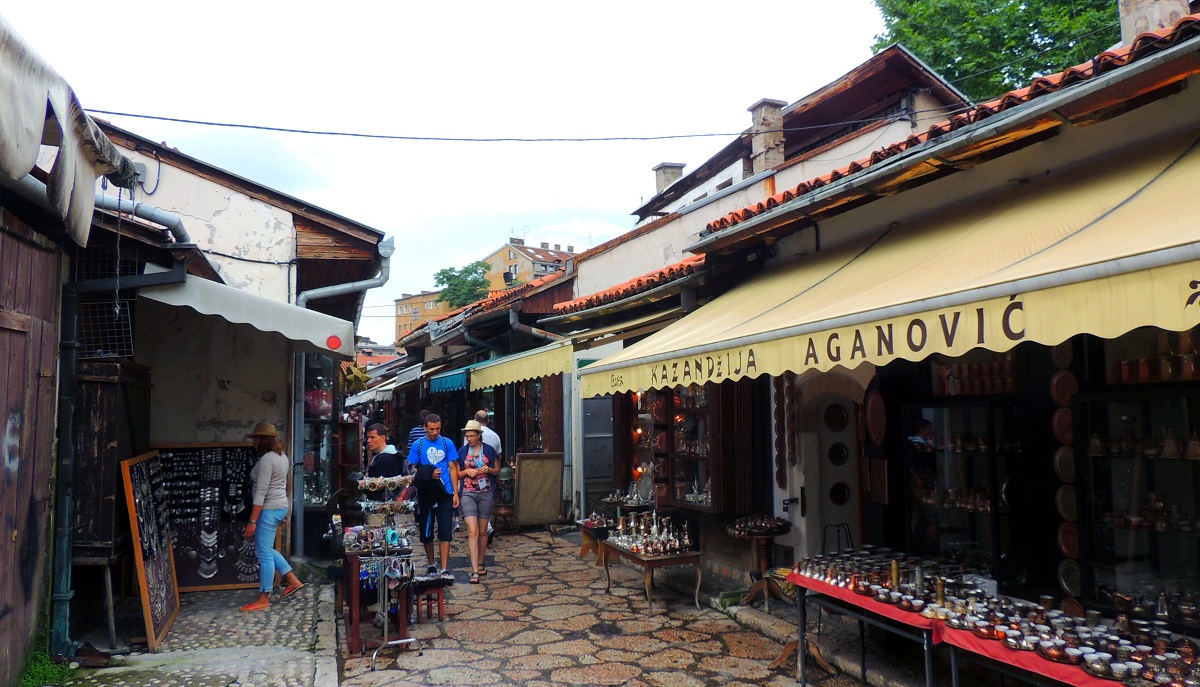
Coppersmith Street is an example of an environment from previous centuries. Locally, the street is called Kazandžiluk, which was named after the coppersmiths who had workshops and stalls here from the 16th century, when the place arose. Kazandžiluk is located at the eastern end of the bazaar quarter and is one of several examples of the cozy and narrow streets that characterize the area.
Gazi Husrev-bey Mosque is one of Sarajevo’s many mosques from the time of the Ottoman Empire. The architect was Acem Esir Ali, whose work was completed in 1531 with a dome of 26 meters in height; the mosque’s minaret measures a whopping 47 meters to the top.
Gazi Husrev Bey, who was Ottoman governor of Bosnia for several periods during the years 1521-1541, was behind the construction. Bey was also the biggest patron of money for construction in Sarajevo.
The prayer room is quite interesting and richly ornamented. The room has been restored after destruction during the siege of the city in the 1990s civil war in the country, and it stands as new again for visitors.
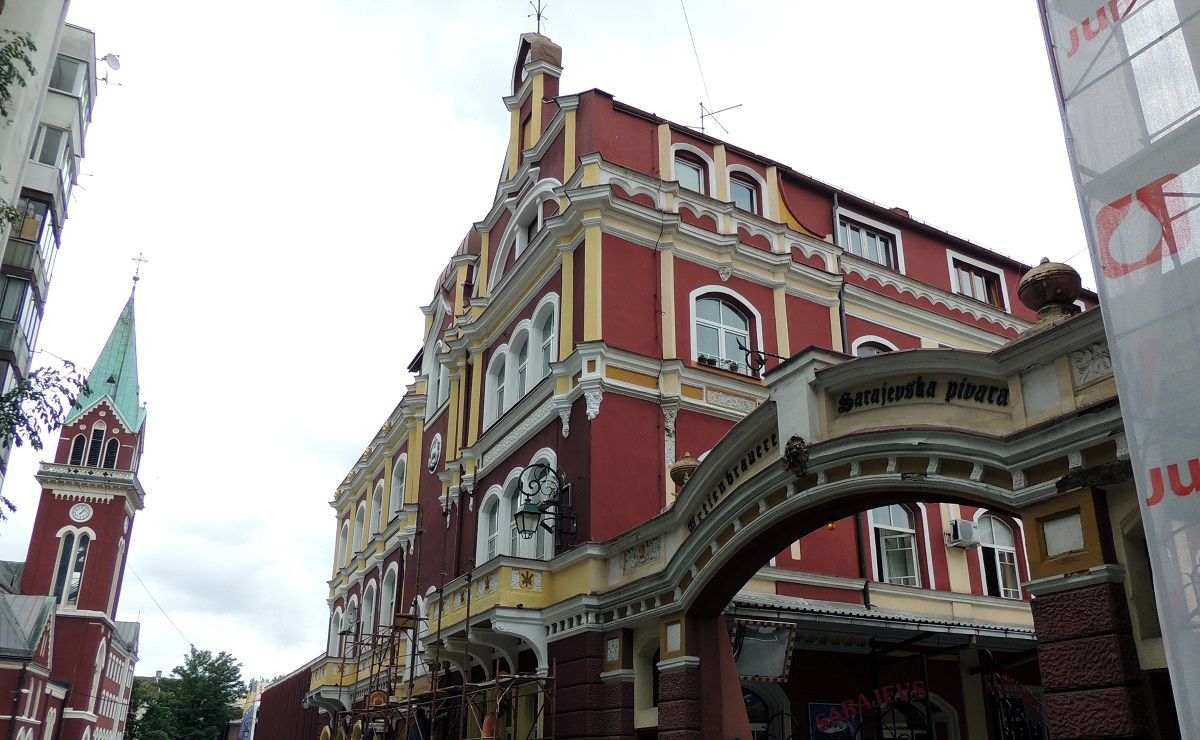
Sarajevo Brewery opened as one of the first major industries in the city in 1864. It quickly became a leader in Bosnia with a major export to neighboring countries. The brewery’s red and white buildings stand today as a beautiful example of industrial construction.
You can taste the brewery’s products in the atmospheric restaurant Pivnica HS, which was established in 2004. The place is also an excellent place to taste Bosnian food.
Museum Sarajevo 1878-1918 is a museum that conveys the city’s history during the period when the city was under the Austrian rule of the Habsburgs. It was also a time that led to the end of the Austro-Hungarian Empire and rule in, among other things, Bosnia and Herzegovina.
Many themes such as the monarchy, industrialization, architecture and culture can be experienced here. An important episode that is naturally treated at the museum is the assassination of the Austrian heir to the throne, Archduke Franz Ferdinand, immediately in front of the museum building on 28 June 1914.
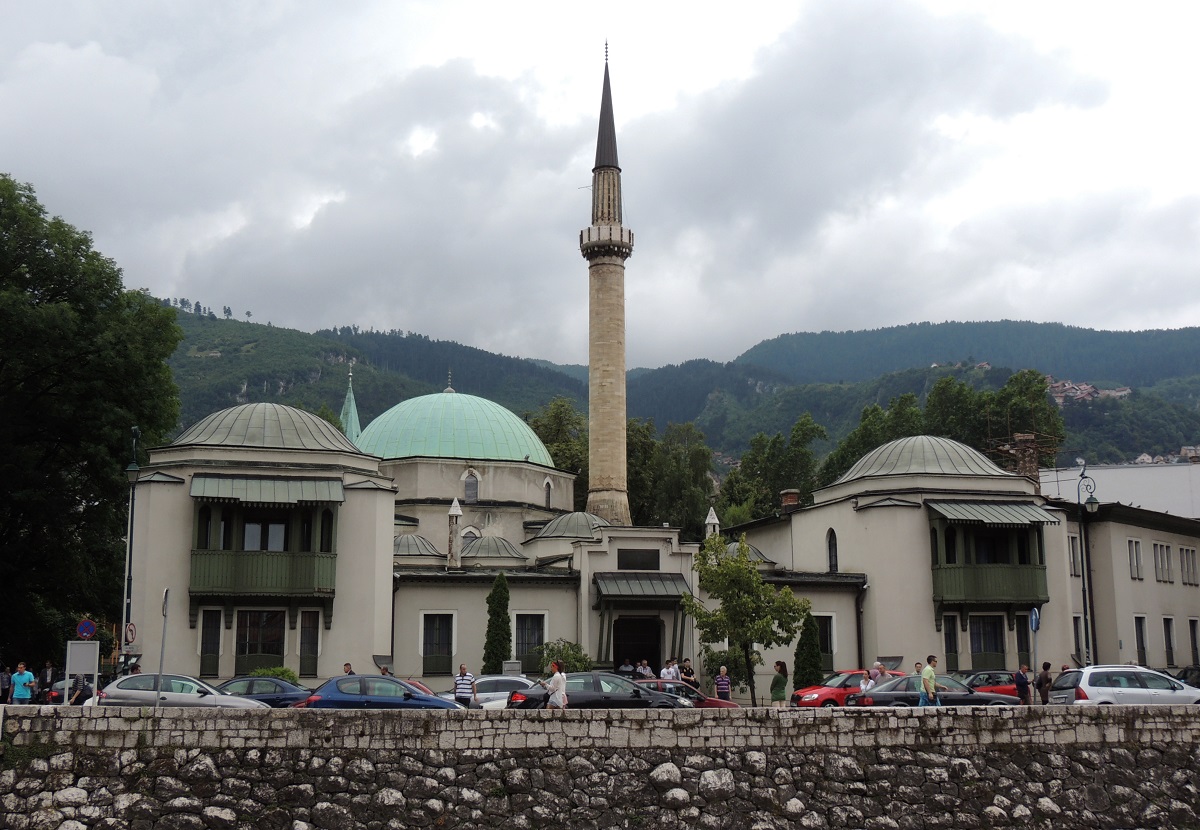
The Imperial Mosque is one of the most important historical buildings in Sarajevo. It was the first mosque to be built after the Ottoman conquest of the area. The city of Sarajevo thus grew around the mosque, and one of the immediate neighboring houses was the residence of the sultan’s local representative.
The mosque was built in wood in 1457 by Isaković-Hranušić, who dedicated and named it after Sultan Mehmed II. The original mosque here was built in the typical Ottoman style of the time, but already fell into disrepair at the end of the 15th century. The mosque was rebuilt in 1565. This time in stone and dedicated to Sultan Suleiman the Mighty. In the 19th century, the mosque was expanded several times to the complex you can see today.
The Historical Museum of Bosnia and Herzegovina was established in 1945 as a museum for the liberation of Bosnia and Herzegovina after World War II. At the time it was located in the city’s town hall and library building, but since 1962 it has been housed in the current purpose-built museum building.
The exhibitions convey the history of Bosnia and Herzegovina from the migrations and conquests of the Slavs in the Balkans and specifically in this area. Themes throughout the centuries are the country’s Ottoman period, 1463-1878, and the time under Austria-Hungary, which lasted from 1878 to the dissolution of the empire in 1918. Finally, there is also the dissemination of recent history from 1918 to the present day, where the war and siege in the 1990s of Sarajevo is in particular focus.
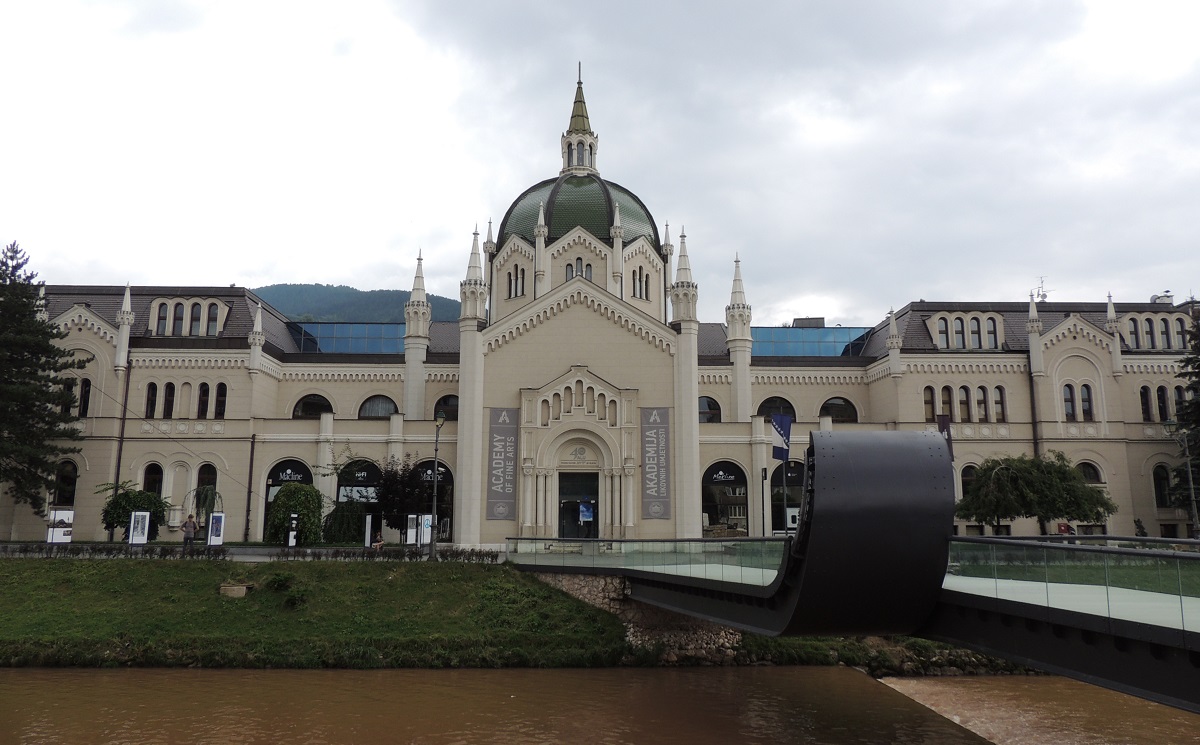
The Sarajevo Art Academy was established in 1972 as part of the city’s university. However, the large and distinctive academy building itself was built with a completely different purpose.
The academy was built in 1899 as a Protestant church during the time of the Austro-Hungarian Empire. The style was grand with inspiration from Romanesque and Byzantine architecture. The church and thus its original purpose was only active until the end of the Austro-Hungarian era, which ended with World War I.
Like so many other buildings of the time in Sarajevo, it was the architect Karel Pařík who was behind the design of the large construction.
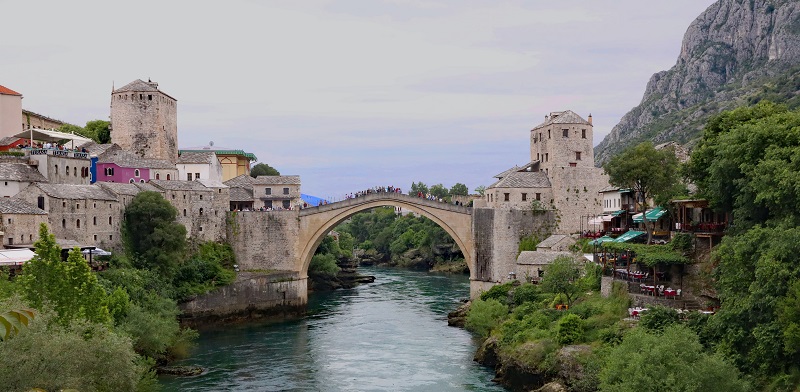
Mostar is one of the main cities of Herzegovina, and its name comes from mostari, referring to the people who stood guard at the city’s old bridge. Mostar is strategically located between the Adriatic Sea and resource-rich central Bosnia, and this gave Mostar growth over the years. In 1468, the city came under Ottoman rule, and Mostar was fortified in the period 1520-1566, which was also the year when Sultan Suleiman the Mighty replaced the city’s old wooden bridge with the current one made of stone, which is Mostar’s landmark.
Stari Most is the central and most famous of Mostar’s bridges. Both the bridge and the surrounding part of Mostar’s old town were included in UNESCO’s list of world cultural heritage in 2005. Stari Most connects the two halves of the city, and over the years there have been jumping competitions from the bridge into the river Neretva. One can enjoy the bridge from the walk above it and from the accessible riverside area below.
Međugorje is a small town in Bosnia and Herzegovina that has been a major Christian pilgrimage destination since 1981. On June 24 this year, a series of repeated apparitions of the Virgin Mary in the form of a spiritual ecstasy started for six people, and there are also reports of terminally ill people being cured here. A papal envoy has investigated the phenomena, which was not enough evidence to make the city an official place of pilgrimage in the Catholic Church.
However, this unofficial status does not deter many from making a pilgrimage here, where you can visit, among other things, the two-towered St. John’s Church/Crkva Sv. Jakova. The church itself is quite modern and beautiful, and in the large area in front of it you can see a statue of the Virgin Mary.
Jajce is a beautiful and cozy provincial town in Bosnia and Herzegovina. It is located at the place where the river Pliva flows into the river Vrbas. Precisely the rivers are part of what has made Jajce a popular tourist town, as there is a 20 meter high waterfall at the confluence.
Jajce’s history started in the 14th century, and for a time it was the capital of the Kingdom of Bosnia, which existed from 1377 to 1463. Jajce was the residence of Stjepan Tomasevic, who became the last Bosnian king; the Muslim Ottomans besieged the city and executed the king in 1463. However, the Ottomans had to give way to a Hungarian after a few months, but they came again in 1527-1528, when Jajce fell into the hands of the Turks as the last Bosnian city.
In addition to the waterfall in the city, you can see Jajce Fortress/Tvrđava Jajce (Harmani), which is located above the city on a hilltop. The fortress was built in the 14th century, and it was here that Stjepan Tomasevic was crowned Bosnian king in 1461. The site’s walls are 1,300 meters long, and together with the hill and the city’s two rivers, they formed the fortress’s defenses. Behind the walls was, among other things, the king’s residence.
This is a bridge that spans the Drina River in eastern Bosnia and Herzegovina. The bridge is on UNESCO’s list of world heritage sites, and it is one of Mimar Sinan’s famous buildings.
The bridge was built in the years 1571-1577, and Sinan was an architect and engineer during this time, architecturally representing the pinnacle of the classical Ottoman style. The bridge, with its many beautiful arches, is approximately 180 meters in length. In addition to the bridge itself, you can enjoy the beautiful surroundings and the city of Višegrad on a trip here.
Franca Lehara 2
alta.ba
Trg djece Sarajeva 1
bbicentar.ba
Vrbanja 1
scc.ba
Ferhadija, Sarači, Baščaršija,
Pionirska dolina
Patriotske lige 58
Playland
Anđela Zvizdovića 1
Zemaljski Muzej Bosne in Hercegovine
Ulica Zmaja od Bosne 3
zemaljskimuzej.ba
The early period in the region around present-day Sarajevo was home to the Butmer culture, not least characterized by finds of finely crafted pottery.
Butmer culture disappeared around the year 2400 BC, and it is believed that it was due to the coming of the Illyrians. The Illyrians settled in several places in the area, and they built various fortifications. The Illyrians were in the area for the growth and strength of the Roman Empire made it impossible for a continued defense; the last battle took place in year 9, after which Emperor Tiberius was able to establish his Roman rule over the region.
Under Rome’s rule, the region and its settlements were part of the province of Dalmatia. Roads went from coast to inland, and through archaeological finds it has been found that trnaport and trade have taken place; also to the present Sarajevo, which in the Roman Empire’s time was still not established as a city.
In the 600s, Slavic tribes came to the Balkans, and in several places replaced the Illyrians, who at this time still constituted the population tribe. The slaves, for example, settled in the Sarajevo Valley. Two settlements were established around what is today Sarajevo, but little is known about these.
Bosnia is first mentioned as a smaller area around the Bosna River, and from the 1100s the region was subject to Hungary as vassal. Central to Bosnia was the area and settlement of Vrhbosna, which may have been at the site that later became Sarajevo. In 1238 it was documented in papal papers that a cathedral dedicated to St. Peter in the city was erected, and this fact could indicate that it was a significant settlement or town.
The Muslim Ottomans spread through a conquest to the European Balkans in the 14th century, where Bosnia also became part of the Ottoman Empire. For Sarajevo it became historically landmark, with the Ottomans establishing the city, which is believed to have happened in 1461.
At that time, the village of Brodac was located on the site where the first Ottoman governor of Bosnia wanted a new city. His name was Isa-Beg Ishaković, and he managed to swap land with the local landowners. It gave Isa-Beg Ishaković the opportunity to establish the new capital of the Ottoman province here. It quickly built a market, bathing facilities, a mosque and a governor’s residence; the so-called saray who came to give Sarajevo his name.
With the heavy construction activity, Sarajevo quickly became the province’s largest and most important city. Merchants from Ragusa came here, and Christians, Jews and Muslims lived side by side.
Sarajevo continued to grow strongly and the city market was the center of many activities. Schools, a library and mosques were established, around 100 of which were erected in the city by the end of the 16th century. Bathing facilities helped make the city one of the most modern in Europe, and Sarajevo was at its peak the Ottomans’ largest city in the Balkans; only Constantinople of the Bosphorus was larger. In 1660, it is estimated that Sarajevo had about 80,000 inhabitants.
Sarajevo’s heyday was the 16th century, where there was a huge construction activity. The 17th century was also characterized by some growth and a relatively rich citizen life, but it was at the same time a century when the decline of the Ottoman Empire began. Of course, it was something that affected all the subordinate and conquered regions and thus also Sarajevo and Bosnia.
In 1697, Austrian troops besieged and robbed Sarajevo, and it was a manifest symbol of the weakening of the Ottoman Empire. During the Austrian attack, the city was severely destroyed and Sarajevo had to be rebuilt from the start to become a large, prosperous and important city again.
At the beginning of the 18th century, the Ottomans moved their administrative seat for the region from Sarajevo to Travnik, which naturally affected Sarajevo’s materiality, which had already suffered a crack in 1697.
The 18th century was a century of stagnation, decline and new catastrophes for Sarajevo. Some were built on top of the destruction in 1697, but the city was hit by major fires in both 1788 and 1797, which put Sarajevo back again.
The 19th century was no better for the city than the end of the 18th century. The Ottoman Empire faltered, and a rising patriotism in many Balkan countries made many wish for freedom, and so did Sarajevo. There were several battles around Bosnia in the first half of the 19th century, and at Sarajevo it was for the last time fought the last battle in 1832. On that occasion the Ottomans won, which created new decades under the Turkish Ottomans.
Throughout the 19th century, the Ottoman Empire became increasingly weakened, and many states were liberated from Turkish supremacy during this time.
In 1878, Sarajevo was conquered by Austria-Hungary, and it came time to signify a high growth in the city to which Western architects and engineers poured. They were to help build Sarajevo as a modern European 19th century city. A fire during this period also led to some rebuilding and the result was a Sarajevo with a mixture of the Ottoman bazaar area and urban districts with western architecture.
After 1878 Sarajevo remained de jure part of the Ottoman Empire, but in fact the city and region were administered as part of Austria-Hungary, which formally annexed the area in 1908. At that time, about 50,000 inhabitants lived in the city.
Sarajevo enrolled in world history in 1914. Austrian Archduke Franz Ferdinand had been crown prince and thereby the successor to the Austro-Hungarian throne since 1896, and in 1914 he was to visit Sarajevo with his wife Sophie. The visit took place on June 28, 1914, when the Crown Prince couple drove through the streets of Sarajevo. Here they were shot and killed by the nationalist Gavrilo Princip, and the murder was instrumental in the outbreak of World War I.
World War I was a war that, among other things, meant that Austria-Hungary ceased to exist. It was of great importance to many countries and Sarajevo became part of the Kingdom of Yugoslavia.
In the first decades of Yugoslavia, Sarajevo’s status and role were reduced from capital to provincial city, and it provided less political and economic importance than before. World War II replaced the interwar period, and Sarajevo was bombed by Germany and captured by Croatian Ustaše, who were fascists. The inaugural war turned for the Germans and Croats, and Sarajevo was liberated on April 6, 1945.
After World War II, Sarajevo became part of Socialist Yugoslavia, and a new period of growth began in the city, the capital of the Bosnian state within the Yugoslav Federation. Yugoslavia invested heavily in Sarajevo, which was expanded and modernized, including many new suburbs with large apartment buildings.
Sarajevo hosted the Olympic Winter Games in 1984, and this year the world’s sports eyes were aimed at the city, which, with the Games as the focal point, experienced a strong period of growth. Expansion with sports arenas, new neighborhoods, hotels and more was part of what brought the city’s population to about 500,000 people.
Sarajevo was a growing city in the 1980s, and it was the capital of one of the states of Yugoslavia, which, together with the rest of Eastern Europe, was facing major political changes. The country consisted of many states from Slovenia in the north to Macedonia in the south, and the desire for independence made some of the Yugoslav states want independence.
Bosnia-Herzegovina declared its independence on March 3, 1992, thereby leaving the country out of Yugoslavia. With Serbs, Croats and Boniaks as population groups, there was great opposition to each other in the following years when it came to war in Bosnia and Herzegovina.
From April 5, 1992 to February 29, 1996, Sarajevo was besieged, and the highlight of the siege took place in 1992-1993, when buildings were shattered and snipers operated around the city, with images of the so-called Sniper Alley going around the world.
After the end of the war in Bosnia and Herzegovina in the 1990s and thus the siege of Sarajevo, the city was partially destroyed and it was to be rebuilt. This great work started in 1995, and ten years later Sarajevo was largely rebuilt.
Today, Sarajevo is thus a beautifully renovated capital with many sights in both the old and new districts. New high-rise buildings and shopping centers have opened up in recent years, and there is peace and quiet to enjoy the beautifully located city in central Bosnia-Herzegovina.

Sarajevo, Bosnia and Herzegovina
Overview of Sarajevo
Sarajevo is the capital of Bosnia-Herzegovina and it is a beautifully located city with many sights to see. The Ottoman Bazaar Quarter is as an atmospheric center, surrounded by the beautiful 19th-century Habsburg buildings, constructed in the decades leading up to World War I, where Sarajevo was growing rapidly.
Sarajevo’s name is historically linked to World War I, when Archduke Franz Ferdinand was murdered during a visit here in 1914. Historically interested visitors can see the place where it happened and learn more about both that year and much more from the city’s history at Sarajevo’s museums.
For centuries, Sarajevo was part of the Ottoman Empire, and hostels, bazaars and mosques are examples of the 16th-century city. Narrow streets and a cozy setting for, among other things, shopping and gastronomy characterize the place today.
About the Whitehorse travel guide
Contents: Tours in the city + tours in the surrounding area
Published: Released soon
Author: Stig Albeck
Publisher: Vamados.com
Language: English
About the travel guide
The Whitehorse travel guide gives you an overview of the sights and activities of the Canadian city. Read about top sights and other sights, and get a tour guide with tour suggestions and detailed descriptions of all the city’s most important churches, monuments, mansions, museums, etc.
Whitehorse is waiting for you, and at vamados.com you can also find cheap flights and great deals on hotels for your trip. You just select your travel dates and then you get flight and accommodation suggestions in and around the city.
Read more about Whitehorse and Canada
Canada Travel Guide: https://vamados.com/canada
City tourism: https://visitwhite-horse.ca
Main Page: https://www.vamados.com/
Buy the travel guide
Click the “Add to Cart” button to purchase the travel guide. After that you will come to the payment, where you enter the purchase and payment information. Upon payment of the travel guide, you will immediately receive a receipt with a link to download your purchase. You can download the travel guide immediately or use the download link in the email later.
Use the travel guide
When you buy the travel guide to Whitehorse you get the book online so you can have it on your phone, tablet or computer – and of course you can choose to print it. Use the maps and tour suggestions and you will have a good and content-rich journey.


The Latin Bridge is a bridge over the river Miljacka that runs through Sarajevo. A bridge is already mentioned at this place in 1541, and this was a wooden bridge, as the stone bridge was first built under the Ottomans in 1565. The bridge stands with four arches and the characteristic holes through two of the bridge piers; this distinctive feature can be found on Sarajevo’s city coat of arms.
The Latin Bridge is not only known because of its ancient history. It was also immediately north of it that Gavrilo Princip shot and killed the Austro-Hungarian heir to the throne on 28 June 1914.
Brusa Bezistan with its six domes is one of the most interesting buildings in the old bazaar area of Baščaršija. The building was built by order of Sultan Suleiman the Mighty’s Grand Vizier Rustem Pasha in 1551, and it was built as a trading post for silk. Brusa Bezistan is also named after the Turkish city of Bursa, from where the offered silk was transported.
The stone building is 29.5×20.5 meters in ground plan, and there are entrances on all four sides. Today, Brusa Bezistan is set up as part of Sarajevo’s museums, and here the city’s history is told from prehistoric times up to and including the Austro-Hungarian era. Around it are shops, as in the rest of the bazaar area, and they help to give the museum extra atmosphere.

Coppersmith Street is an example of an environment from previous centuries. Locally, the street is called Kazandžiluk, which was named after the coppersmiths who had workshops and stalls here from the 16th century, when the place arose. Kazandžiluk is located at the eastern end of the bazaar quarter and is one of several examples of the cozy and narrow streets that characterize the area.
Gazi Husrev-bey Mosque is one of Sarajevo’s many mosques from the time of the Ottoman Empire. The architect was Acem Esir Ali, whose work was completed in 1531 with a dome of 26 meters in height; the mosque’s minaret measures a whopping 47 meters to the top.
Gazi Husrev Bey, who was Ottoman governor of Bosnia for several periods during the years 1521-1541, was behind the construction. Bey was also the biggest patron of money for construction in Sarajevo.
The prayer room is quite interesting and richly ornamented. The room has been restored after destruction during the siege of the city in the 1990s civil war in the country, and it stands as new again for visitors.

Sarajevo Brewery opened as one of the first major industries in the city in 1864. It quickly became a leader in Bosnia with a major export to neighboring countries. The brewery’s red and white buildings stand today as a beautiful example of industrial construction.
You can taste the brewery’s products in the atmospheric restaurant Pivnica HS, which was established in 2004. The place is also an excellent place to taste Bosnian food.
Museum Sarajevo 1878-1918 is a museum that conveys the city’s history during the period when the city was under the Austrian rule of the Habsburgs. It was also a time that led to the end of the Austro-Hungarian Empire and rule in, among other things, Bosnia and Herzegovina.
Many themes such as the monarchy, industrialization, architecture and culture can be experienced here. An important episode that is naturally treated at the museum is the assassination of the Austrian heir to the throne, Archduke Franz Ferdinand, immediately in front of the museum building on 28 June 1914.

The Imperial Mosque is one of the most important historical buildings in Sarajevo. It was the first mosque to be built after the Ottoman conquest of the area. The city of Sarajevo thus grew around the mosque, and one of the immediate neighboring houses was the residence of the sultan’s local representative.
The mosque was built in wood in 1457 by Isaković-Hranušić, who dedicated and named it after Sultan Mehmed II. The original mosque here was built in the typical Ottoman style of the time, but already fell into disrepair at the end of the 15th century. The mosque was rebuilt in 1565. This time in stone and dedicated to Sultan Suleiman the Mighty. In the 19th century, the mosque was expanded several times to the complex you can see today.
The Historical Museum of Bosnia and Herzegovina was established in 1945 as a museum for the liberation of Bosnia and Herzegovina after World War II. At the time it was located in the city’s town hall and library building, but since 1962 it has been housed in the current purpose-built museum building.
The exhibitions convey the history of Bosnia and Herzegovina from the migrations and conquests of the Slavs in the Balkans and specifically in this area. Themes throughout the centuries are the country’s Ottoman period, 1463-1878, and the time under Austria-Hungary, which lasted from 1878 to the dissolution of the empire in 1918. Finally, there is also the dissemination of recent history from 1918 to the present day, where the war and siege in the 1990s of Sarajevo is in particular focus.

The Sarajevo Art Academy was established in 1972 as part of the city’s university. However, the large and distinctive academy building itself was built with a completely different purpose.
The academy was built in 1899 as a Protestant church during the time of the Austro-Hungarian Empire. The style was grand with inspiration from Romanesque and Byzantine architecture. The church and thus its original purpose was only active until the end of the Austro-Hungarian era, which ended with World War I.
Like so many other buildings of the time in Sarajevo, it was the architect Karel Pařík who was behind the design of the large construction.
Similar to Sarajevo Travel Guide
